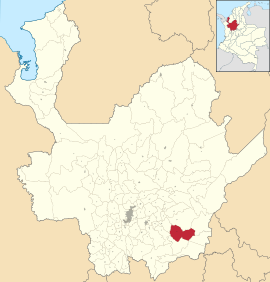San Luis, Antioquia facts for kids
Quick facts for kids
San Luis
|
||
|---|---|---|
| Municipio de San Luis en Antioquia | ||
|
||

Location of San Luis in the Antioquia Department
|
||
| Country | ||
| Founded | 25 August 1876 | |
| Government | ||
| • Body | Alcaldía de San Luis | |
| Area | ||
| • Total | 392 km2 (151 sq mi) | |
| Elevation | 1,005 m (3,297 ft) | |
| Population
(Census 2018)
|
||
| • Total | 7,155 | |
| • Density | 18.253/km2 (47.27/sq mi) | |
| Time zone | UTC-5 (Colombia Standard Time) | |
| Area code(s) | +57 4 | |
San Luis is a small town, also called a municipality, in Colombia. It is found in the Antioquia region. San Luis is surrounded by other towns. To the north are San Carlos and Puerto Nare. To the east is Puerto Triunfo. To the south is San Francisco. And to the west are Cocorná and Granada.
The weather in San Luis is usually warm. The average temperature is about 28 Celsius (82 Fahrenheit). The town is about 124 kilometers (77 miles) away from Medellín. Medellín is the capital city of the Antioquia region. San Luis covers an area of 453 square kilometers (175 square miles). In 2018, about 7,155 people lived there.
Contents
How San Luis Began
San Luis has a shorter history compared to many other towns in Antioquia. People started moving to this area in 1875. This movement continued through the late 1800s. People were looking for new opportunities. They also wanted to explore and settle new lands.
The person often called the founder of San Luis is Clemente Giraldo. He was a priest. He wanted to create a trading spot. This spot would be between the city of Granada and the Río Magdalena river. Giraldo arrived in the area from Granada with several families. They reached a large stone cliff on August 25, 1876. This date is now the official founding day of San Luis.
Giraldo found a good spot in the mountains. It was easy to defend and had lots of wood. He decided it was perfect for a new settlement. The settlers planted banana trees, beans, sugar cane, and yuca. They wanted to see if the soil was good for farming. After a successful harvest, they went back to Granada. They shared the good news about their new home.
More settlers came after hearing about the successful new town. They arrived from nearby places like El Peñol, Marinilla, and El Santuario. By 1878, the town had built its first church. It also had a central park. San Luis then became part of the larger municipality of San Carlos.
San Luis After the Conflict
San Luis has grown a lot since 2006. It has improved both its economy and its culture. Argos S.A., a big cement company in Colombia, started working in San Luis in 1985. They greatly expanded their operations in 2006. This created jobs for more than 500 people. They also invested over $700 million US dollars.
Since 2015, the town has seen a lot of new building. A big project called Porvenir II is underway. It includes building a dam, a hydropower plant, and a lake. This new lake is expected to bring even more visitors to San Luis.
Population of San Luis
Here's a look at how many people live in San Luis:
- Total Population: 10,939 people (as of 2015)
- Urban Population: 4,694 people live in the town center.
- Rural Population: 6,245 people live in the countryside areas.
Economy of San Luis
The main way people in San Luis make a living is through farming. The economy relies heavily on growing fruits and vegetables. Raising livestock (farm animals) is also important. A big part of the economy is also about harvesting and selling wood. The town celebrates its wood industry every year. This happens on the last weekend of June. It's called the "Fiestas de la Madera" (Festival of the Wood).
Exploring Nature: Ecotourism
San Luis is becoming a popular place for tourists. The tourism here focuses on being eco-friendly. This means enjoying nature while protecting it. The town has several interesting places to visit. Both visitors and local people enjoy these spots.
- Cascada la Cuba (The Cuba Waterfall): This waterfall is right by the road leading into town. It's about 1.6 kilometers (1 mile) from the main highway. The water drops more than 100 meters (328 feet). People visit it for its clean water and beautiful natural surroundings.
- Cascada La Planta (The Plant Waterfall): To reach this waterfall, you walk down a steep, narrow stone path. The waterfall is 30 meters (98 feet) tall. At the bottom, there's a pool of water about 15 by 10 meters (49 by 33 feet). Visitors can swim in this pool. There's also a diving platform for those who want to jump in.
- El Dormilón (Dormilón River): The banks of this river are great for picnics. The river currents are gentle, so it's safe to swim here.
- Iglesia de San Luis Gonzaga (Church of San Luis Gonzaga): This is the church located in the town's central park. It was built a long time ago, in 1884.
See also
 In Spanish: San Luis (Antioquia) para niños
In Spanish: San Luis (Antioquia) para niños



